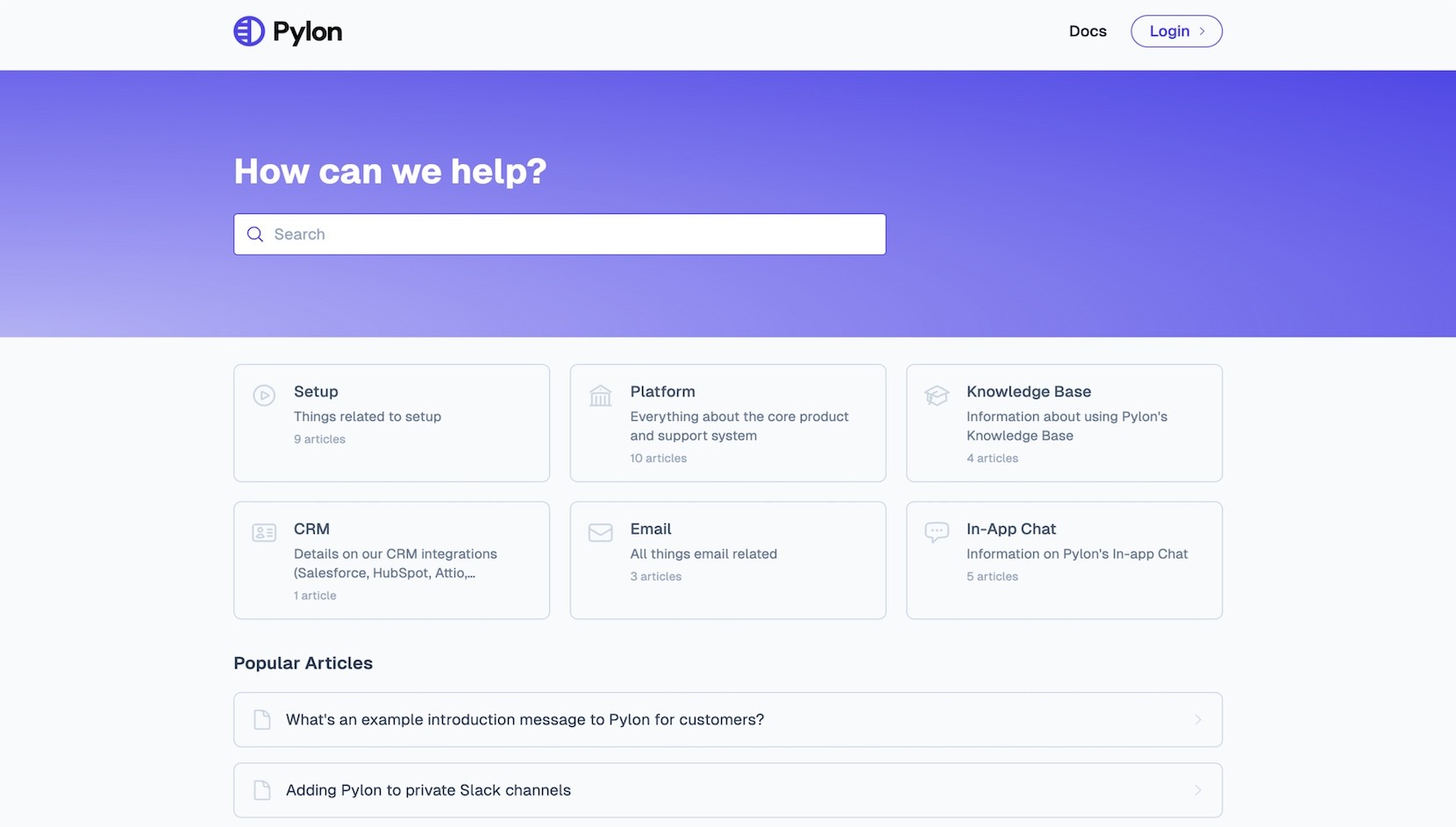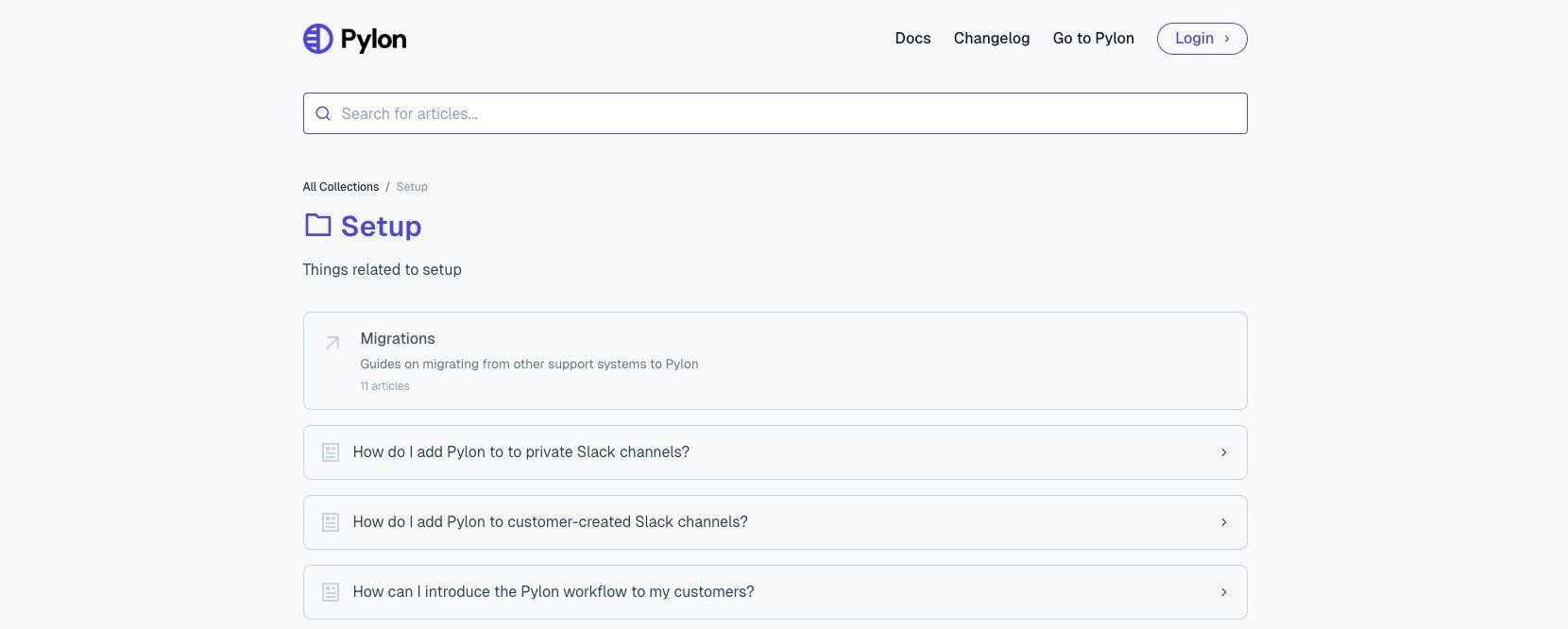Best Practices for Creating a B2B Knowledge Base
We go over best practices for creating a B2B knowledge base, including choosing a platform, determining what content to create, & more.
Creating a successful B2B knowledge base requires more than writing a few support articles.
It’s about building a content strategy that helps your users at every stage, from onboarding to troubleshooting to advanced product adoption.
Here are some best practices for creating your B2B knowledge base.
Best Practices for Creating a B2B Knowledge Base
1) Choose the right platform
Your knowledge base is the foundation of your support documentation. It needs to be easy to use, scalable, and compatible with your existing tools.
Platforms like Pylon are built specifically for B2B companies. Pylon makes it easy to create and manage your knowledge base alongside support tickets, conversations, and team workflows.
With Pylon, your team can:
- Write and organize articles with no code required
- Automatically surface relevant help docs in Slack and other channels
- Track article performance to improve over time
- Sync documentation with support platforms for seamless agent workflows
- Automatically uncover missing knowledge base topics and generate articles based on customer conversations
Choosing the right platform makes publishing easier and ensures your content is discoverable and useful, taking your B2B customer support to a new level.
2) Determine what content to include
Start by identifying the most common questions, pain points, and workflows your users encounter, and create knowledge base article templates for them.
Your goal is to proactively answer these questions before they become support tickets, helping reduce strain on your support team while improving the user experience.
Ways to find this information include:
- Reviewing support tickets and customer chat logs
- Asking your customer success and onboarding teams for FAQs
- Using analytics to identify repeat topics or frequent searches
- Surveying customers directly to understand their needs and challenges
Prioritize articles that:
- Help users complete critical setup steps
- Resolve frequent issues
- Highlight features that are underused but valuable
A good knowledge base grows over time, so don’t feel pressured to cover everything at once. Start with high-impact content that delivers immediate value, then expand based on customer feedback, product updates, and evolving support trends.
3) Identify the most helpful knowledge base structure
A clear structure is essential for helping users find what they need quickly. A well-organized knowledge base reduces friction, encourages self-service, and ensures that users can solve problems without needing to contact support.
Start by organizing your content into intuitive categories and subcategories based on product features, use cases, or user roles.

Best practices for structuring your content:
- Group articles under headings like “Getting Started,” “Integrations,” “Troubleshooting,” or “Billing.”
- Limit the number of top-level categories to avoid overwhelming users and keep navigation simple.
- Make sure your homepage highlights the most important or most frequently accessed topics.
- Use breadcrumbs or sidebar navigation to help users see where they are and explore related content.
- Include a prominent search bar to support users who prefer to search rather than browse.
As your knowledge base grows, a strong structure becomes even more critical. It improves discoverability, reduces cognitive load, and lays the foundation for easily scaling your documentation over time.
Regularly review and refine your structure based on content performance and user behavior.
>> Looking for inspiration? See B2B knowledge base examples here
4) Simplify complex language
Your knowledge base should be easy to read and understand for both technical and non-technical users.
Clear, accessible language helps users absorb information quickly, reduces frustration, and ensures that your content serves a wide audience. This is especially essential for SaaS knowledge bases for complex products.
Aim for a tone that's helpful and straightforward, avoiding dense blocks of text or overly technical explanations unless absolutely necessary.
Tips for simplifying content:
- Break long paragraphs into bullet points or numbered lists to improve scanability.
- Use screenshots, annotated images, or video walkthroughs to visually support written instructions.
- Write in an active voice and use clear, consistent headings to guide readers through each section.
- Explain why a step matters—not just how to do it—so users understand the bigger picture.
- Replace internal jargon or product-specific terminology with plain language or define it clearly on first use.
- Avoid filler words or vague phrases that could introduce ambiguity.
- Make your content skimmable by bolding key terms or using callout boxes for important notes.
Finally, encourage users to leave feedback on each article so you can identify areas that are confusing or unclear and refine them over time. Clear language leads to better outcomes.
5) Set up clear navigation
Even the best-written content won’t help your users if they can’t find it. Clear, intuitive navigation is essential for a smooth self-service experience.
When users can quickly locate relevant information, they’re more likely to solve issues on their own—reducing support volume and increasing satisfaction.

Navigation best practices:
- Organize content into logical categories and subcategories based on user goals, product areas, or task types.
- Add a prominent search bar that supports partial matches, synonyms, and keywords for better accuracy.
- Include a floating or embedded chatbot that can guide users and suggest contextually relevant articles in real-time.
- Use anchor links or tables of contents for longer guides so users can jump straight to the section they need.
- Highlight featured articles or most-viewed topics on the homepage to surface high-value content quickly.
- Use consistent icons, colors, or layout patterns to help users navigate more intuitively.
Consider how your users typically access help—whether through your app, website, or another platform.
Tools like Pylon let you embed smart article suggestions directly in Slack for customer support or power in-app searches that deliver the right answers without requiring users to leave their workflow.
The easier it is to find help, the more likely users are to engage with your knowledge base—and trust it as a reliable resource.
6) Establish a review process
It’s important to review your knowledge base consistently so you can keep it up to date. Here are some tips on establishing a review process:
- Schedule quarterly or biannual audits to review all knowledge base content for accuracy and relevance.
- Update articles immediately when features change, interfaces are redesigned, or new functionality is released.
- Monitor high-traffic pages using analytics tools and prioritize improvements to those that impact the most users.
- Use article feedback tools (thumbs up/down, comments, survey responses) to spot unclear or outdated content.
- Assign ownership of each article to specific team members to ensure accountability and timely updates.
- Create a changelog or “What’s New” section to inform users of recent documentation updates.
Treat your knowledge base as a living, evolving resource—not a set-it-and-forget-it project.
Regular updates not only keep content accurate but also show users that you’re invested in helping them succeed.
This ongoing attention pays off in reduced support volume, increased customer confidence, and a stronger self-service experience.
7) Optimize for SEO
Many users will discover your knowledge base through search engines. Optimizing your content for SEO can increase traffic and reduce support burden.
SEO tips for your knowledge base:
- Use clear and unique H1s, title tags, and meta descriptions for each article.
- Write readable URLs that reflect the article’s topic (e.g., /how-to-reset-password).
- Ensure articles are indexable by search engines.
- Link to knowledge base articles from blog posts, onboarding emails, and product UIs.
- Include internal links between related help articles to keep users engaged.
Search-optimized documentation brings in new users and supports existing ones more effectively.
8) Make it easily accessible from the main part of the site or app
Your knowledge base should be easy to find without digging. If users can’t locate your documentation quickly, they’ll either give up or go straight to your support team.
Visibility is key to driving adoption and ensuring users treat your knowledge base as a first stop, not a last resort.

Ways to make it accessible:
- Add a clearly labeled “Help,” “Support,” or “Docs” link in your main website or app navigation bar.
- Include in-app help widgets or tooltips that surface relevant articles based on the user’s current page or task.
- Pin links to documentation in shared Slack channels, product update messages, or key support touchpoints.
- Embed knowledge base links in onboarding flows, welcome emails, and empty states within your user interface.
- Place context-sensitive links within error messages or settings pages to guide users to solutions when needed.
If your platform supports it, offer an integrated experience where users can view documentation alongside open support tickets or chat conversations. This reduces context switching and keeps users informed as they troubleshoot.
The more seamlessly your knowledge base is woven into the product experience, the more likely users are to rely on it for fast, self-serve answers.
Steps to Setting Up a Knowledge Base for Your B2B Company
Creating a knowledge base from scratch can seem daunting, but a step-by-step approach keeps things manageable. Follow these steps to build a system that scales with your product and customer base.
1) Choose a knowledge base platform
Start by selecting a platform that aligns with your team’s workflow and technical needs. It should be intuitive, offer robust content management, and include built-in analytics and search capabilities.
For B2B use cases, integration with your support stack—like Slack, ticketing platforms, and CRM—is critical.
Platforms like Pylon streamline this process by connecting help documentation directly to support workflows and making content accessible where your team and customers already communicate.
While there is a lot of free knowledge base software out there, these platforms often don't offer the necessary features to create a strong knowledge base that saves your support team time and keeps your customers happy.
2) Identify your audience’s key questions and needs
Understanding what your users need is the cornerstone of a valuable knowledge base. Analyze support tickets, live chat logs, and interview insights to pinpoint high-frequency issues or common product roadblocks.
Pay special attention to patterns across customer types, such as admins versus end users or enterprise versus startup clients.
Documenting these pain points helps you prioritize content that delivers the most value early on.
3) Plan the structure and organization
Your knowledge base should be easy to browse and scale as you add more content.
Start by outlining categories that reflect your product’s modules or your customers’ workflows. Break down large topics into subcategories to prevent readers from becoming overwhelmed and to enable faster discovery.
A clear structure reduces confusion, shortens search time, and improves overall usability.
4) Create and format content
Once your structure is in place, begin writing content that’s concise, scannable, and easy to follow. Use step-by-step instructions paired with screenshots or videos for clarity. Stick to plain language and explain technical terms when needed.
Following SEO best practices—like using descriptive headings and internal linking—helps ensure content is findable both inside your site and on search engines.
5) Set up navigation and search
To make your knowledge base easy to use, navigation and search must be top priorities. Add a prominent search bar that supports natural language and partial matches. Use filters or categories to help users drill down to the right topic.
Consider integrating a chatbot or virtual assistant to surface relevant articles in real-time.
6) Launch and share your knowledge base
Once your core articles are ready, publish your knowledge base and make it visible throughout your product and website. Add links in your site navigation, onboarding flows, support channels, and Slack messages.
Announce the launch to both customers and internal teams so they know where to find and share help resources. Continued promotion ensures your documentation becomes a go-to asset, not a buried page.
7) Collect feedback and usage data
After launch, track how users engage with your knowledge base to find what’s working—and what’s not. Enable feedback tools so users can rate articles or suggest improvements. Monitor traffic data to identify high-performing content and detect gaps where new content may be needed.
Insights from usage data guide your editorial roadmap and help your knowledge base evolve alongside your product.
8) Update and improve content regularly
A knowledge base should be treated as a living document. Align your content review cycle with product updates, new feature releases, and evolving customer questions. Assign owners to specific sections so nothing falls through the cracks.
Keeping documentation current ensures users can rely on it for accurate, helpful guidance—without needing to file a support ticket.












